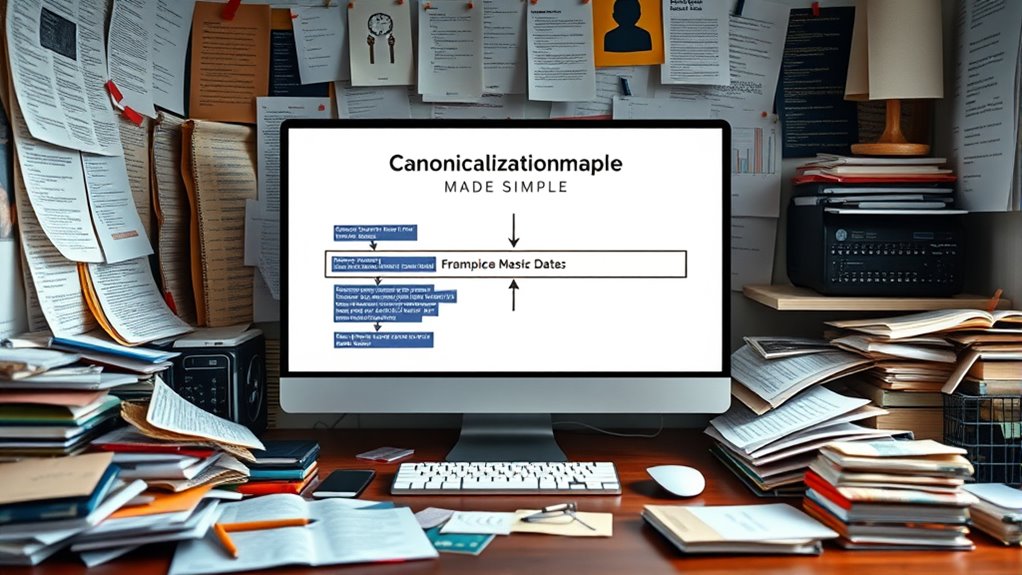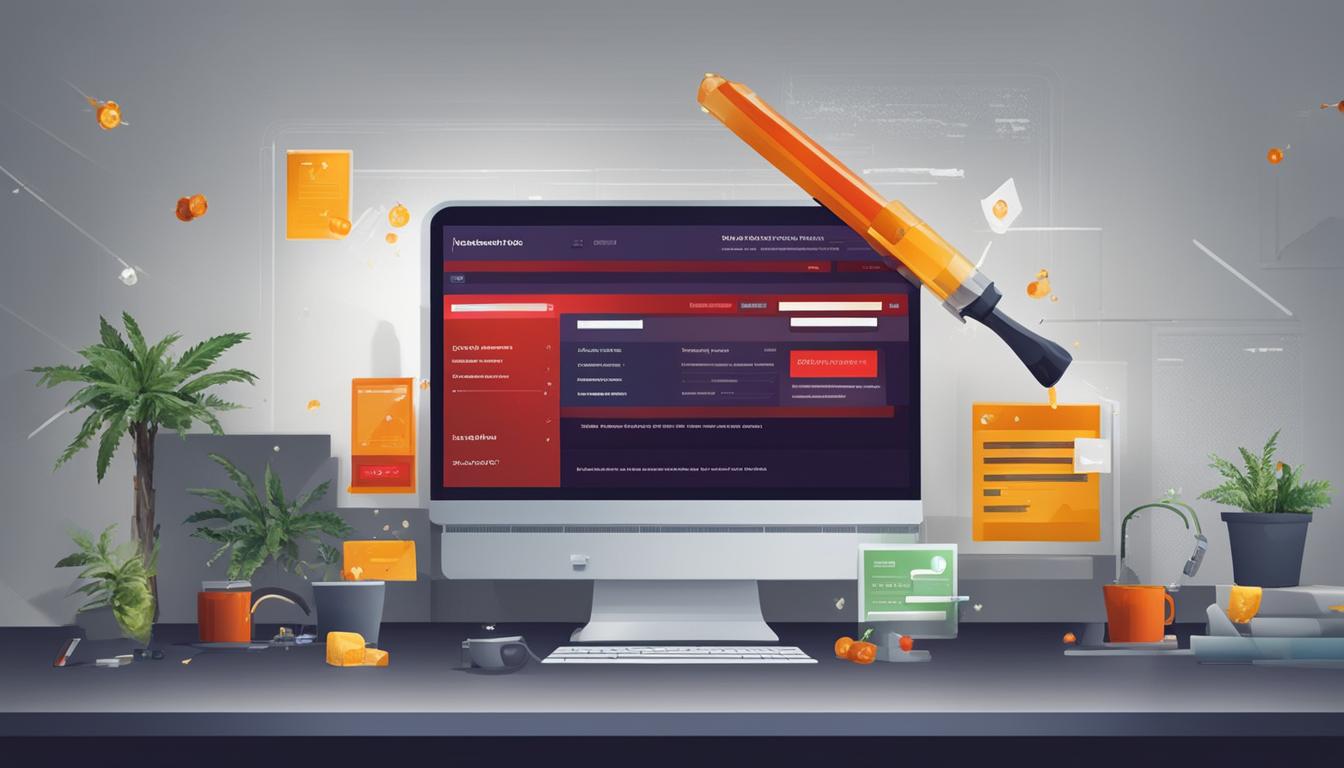Canonicalization is about standardizing data and URLs so everything aligns consistently. It helps you avoid duplicates, errors, and confusion by establishing clear rules for formatting names, dates, and web addresses. Using tools like rel=”canonical” tags or server redirects, you make sure search engines see only your preferred version, boosting your site’s visibility. Understanding these basics makes managing your data and SEO much simpler—keep exploring to learn how to implement these strategies effectively.
Key Takeaways
- Canonicalization standardizes data formats to ensure consistency and accuracy across systems and sources.
- It prevents duplicate entries and errors by converting varied data into a uniform format.
- In SEO, canonical tags specify preferred URLs to avoid duplicate content issues.
- Implementing canonicalization involves setting clear formatting rules and using automated tools.
- Benefits include improved data quality, better search rankings, and streamlined data management.

Canonicalization is the process of converting data into a standard, consistent format to guarantee accuracy and uniformity across systems. When working with data from multiple sources or different platforms, inconsistencies can cause errors, misinterpretations, or duplicate entries. By applying canonicalization, you ensure that all data adheres to a unified format, making it easier to compare, analyze, and store. This step is essential in areas like web development, data integration, and search engine optimization, where uniformity directly impacts performance and reliability.
Imagine you’re managing a database with customer information collected from various channels. Without canonicalization, one system might record a customer’s name as “Jon Smith,” another as “Jonathan Smith,” and yet another as “J. Smith.” These discrepancies can lead to duplicate records or mistaken identities. By implementing canonicalization rules, you can define a standard format—perhaps storing all names as “First Last” in a specific case—so that every entry aligns perfectly. This process simplifies data management and reduces the risk of errors, saving you time and resources down the line.
Managing customer data from multiple sources? Standardize names to prevent duplicates and errors efficiently.
In web development, canonicalization plays a vital role in SEO. Search engines might see multiple URLs leading to the same content, such as “http://example.com/page” and “https://www.example.com/page/”. Without canonicalization, search engines could split ranking signals between these URLs, diluting your page’s authority. By specifying a canonical URL, you tell search engines which version to prioritize, consolidating page ranking and avoiding duplicate content issues. This makes your site more efficient and improves its visibility in search results.
To make canonicalization straightforward, start with clear rules for data formatting. Decide on standard date formats, case conventions, and consistent naming schemes. Use automated tools or scripts to enforce these rules during data entry or processing. For web content, implement rel=”canonical” tags in your HTML or configure server redirects to point all variations to a single preferred URL. These steps help maintain consistency without requiring constant manual adjustments. Additionally, understanding common content inconsistencies helps in designing effective canonicalization strategies.
Frequently Asked Questions
How Does Canonicalization Impact Website SEO Rankings?
Canonicalization directly impacts your website’s SEO rankings by consolidating duplicate or similar content into a single preferred version. When you use canonical tags correctly, search engines understand which page to index, preventing duplicate content issues that can dilute your ranking signals. This improves your site’s authority and visibility, ensuring your most important pages rank higher. Proper canonicalization helps search engines efficiently crawl and index your site, boosting your overall SEO performance.
What Tools Can Automate Canonical URL Implementation?
You can automate canonical URL implementation using tools like Google Search Console, which helps identify duplicate content issues and suggests canonical tags. Other options include SEO plugins like Yoast SEO or All in One SEO Pack for WordPress, which automatically set canonical URLs. Additionally, website crawlers like Screaming Frog or Ahrefs can scan your site, identify duplicate pages, and recommend canonicalization strategies, streamlining the process and improving your SEO efforts.
Are There Risks Associated With Incorrect Canonical Tags?
Yes, incorrect canonical tags can cause chaos in your website’s SEO. You risk confusing search engines, which might index the wrong pages or ignore your valuable content altogether. This confusion can lead to a dramatic drop in rankings, loss of traffic, and missed opportunities. You could spend hours fixing issues that stem from simple mistakes, so it’s vital to get canonical tags right and double-check them regularly.
How Often Should Canonical URLS Be Reviewed?
You should review your canonical URLs at least once a quarter to make certain they stay accurate and effective. Regular checks help you catch issues like broken links or outdated URLs that might harm your SEO. If you frequently update your website or add new content, consider reviewing canonical tags monthly. Staying proactive prevents duplicate content problems and improves search engine indexing, ultimately boosting your site’s visibility.
Can Canonicalization Solve Duplicate Content Issues Across Domains?
Canonicalization can definitely help you tame duplicate content issues across domains, acting like a lighthouse guiding search engines to the main version of your pages. By setting canonical URLs, you tell search engines which page to prioritize, reducing confusion and avoiding split ranking signals. This strategy clears the fog, ensuring your intended content gets the recognition it deserves, and helps your SEO efforts stay focused and effective across multiple domains.
Conclusion
Just like King Arthur trusted his sword to bring order to chaos, embracing canonicalization simplifies your web structure, making it clearer and more efficient. When you standardize your URLs and eliminate duplicates, you harness the power of a well-organized kingdom—your site. Remember, in the quest for better SEO, clarity is your Excalibur. Keep your data aligned, and watch your site’s authority and rankings soar like a legend reborn.









